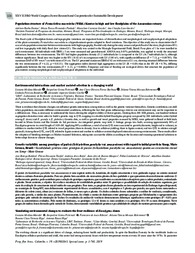Population structure of Pentaclethra macroloba (Willd.) Kuntze in high and low floodplains of the Amazonian estuary.
Population structure of Pentaclethra macroloba (Willd.) Kuntze in high and low floodplains of the Amazonian estuary.
Author(s): DANTAS, A. R.; PIEDADE, M. T. F.; GUEDES, M. C.; LIRA-GUEDES, A. C.
Summary: The flood cycle of floodplain forests and topographic variations are important factors of diversification and morphological and ecophysiological adaptations of the plant community. Pentaclethra macroloba is a hyperdominant species adapted to flood variations. The objective of this study was to characterize the P. macroloba population structure between environments with high topography, flooded only during the rainy season and peak flood of the river, (high várzea-HV) and low topography with daily flood (low várzea-LV). The study was carried in the Mazagão Experimental Field, Brazil. Four plots of 1 ha were installed in each environment. All individuals with DBH ≥ 5 cm were measured and georeferenced. ANOVA test, 0.05% probability, was applied to verify the structural differences between two environments. The HV had higher population density (51.2 individuals.ha-1) compared to the LV (36.7 individuals.ha-1), although without significance. Basal area was higher in the HV (10.42 m²) in comparison with LV (5.90 m²), with significant difference (F = 7.13, p = 0.00795). The maximum DAP of HV was 67 cm with mean of 24 cm. The LV presented maximum DBH of 42 cm with mean of 21 cm, showing structural difference between the two environments (F = 6.22, p = 0.0131). The aggregation index showed high aggregation in the LV (R = 0.89) than in the HV (R = 0.79), differing significantly between the two environments (F = 11.31, p = 0.0008). Frequency and time of flooding are ecological drives that structure the population of pracaxizeiro causing morphological and ecophysiological adaptations to the individual.
Publication year: 2019
Types of publication: Abstract in annals or event proceedings
Unit: Embrapa Amapá
Keywords: Dinâmica Populacional, Pracaxi
Observation
Some of Embrapa's publications are published as ePub files. To read them, use or download one of the following free software options to your computer or mobile device. Android: Google Play Books; IOS: iBooks; Windows and Linux: Calibre.
Access other publications
Access the Agricultural Research Database (BDPA) to consult Embrapa's full library collection and records.
Visit Embrapa Bookstore to purchase books and other publications sold by Embrapa.

